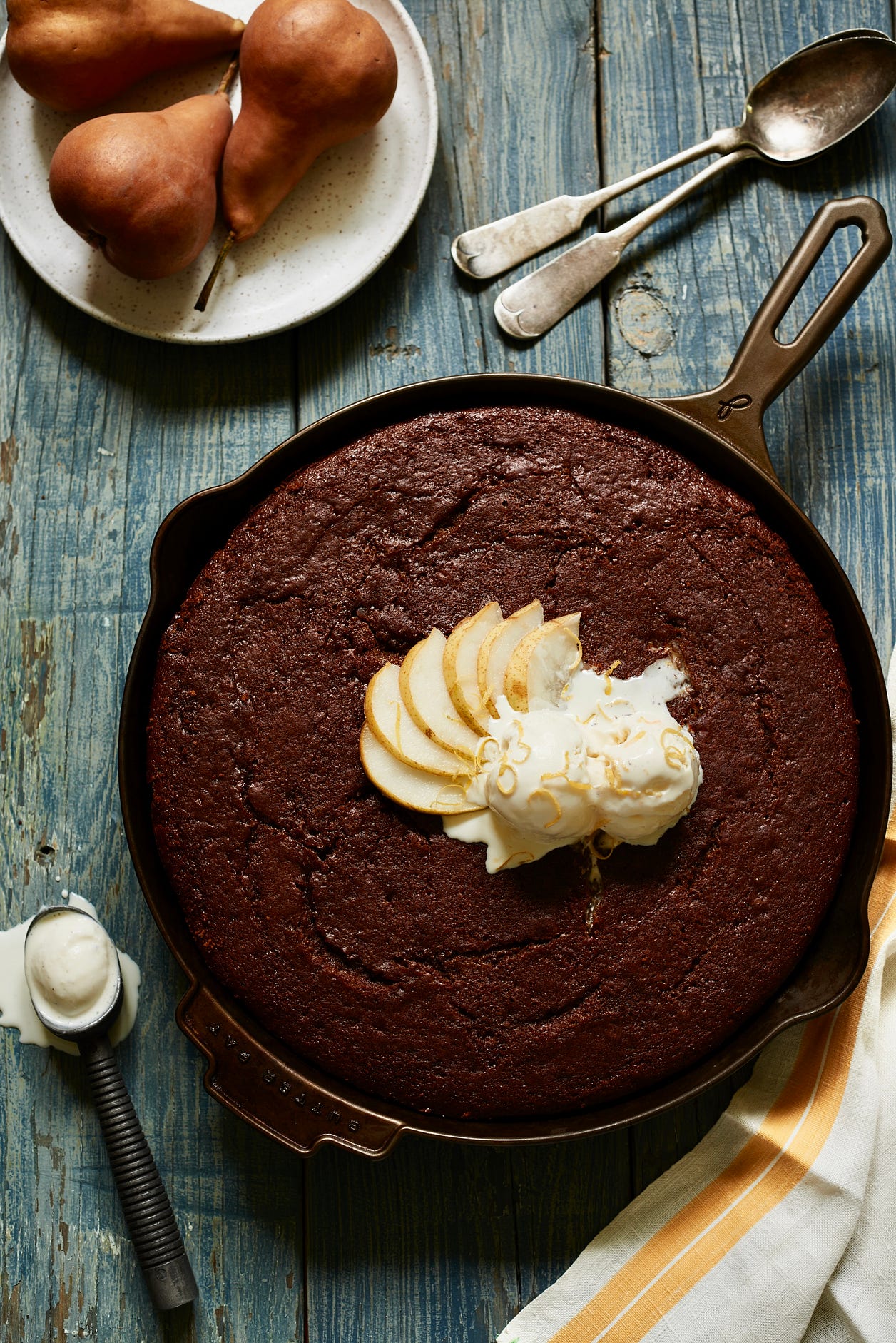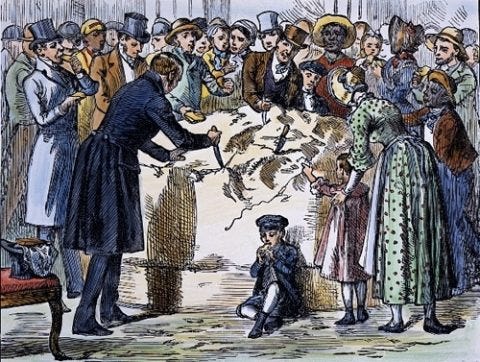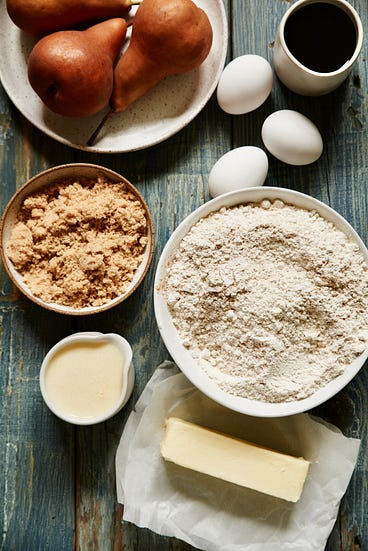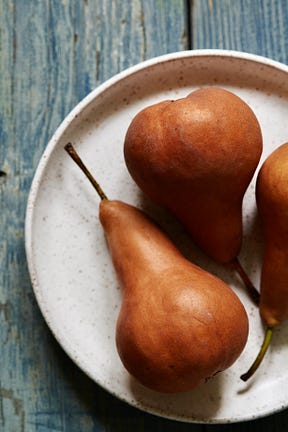Welcome to the free issue of Between the Layers: An honest conversation about life through the lens of cooking and baking. For more recipes and 24/7 access to the growing recipe archives, as well as the new series, Cake in Other Places, consider becoming a Paid Subscriber. The Deep, Dark Secret of Election Food - No. 165It’s Election Day so bake a Pear Skillet GingerbreadIT’S ELECTION DAY IN AMERICA, and you might be standing in line to vote or patting yourself on the back for voting early. Either way, do you smell gingerbread baking in the distance? If this was Knott County, in eastern Kentucky, 60 years ago, you might not only smell gingerbread but you’d be offered some. Soft, still warm, fragrant with cinnamon and ginger, who knows if it was more effective than TV to grab a few votes. But this was before ads cost millions and back when a super PAC was your mom, your gran, and a few great-aunts. They’d gather in the kitchen and bake gingerbread and everyone who ever wanted another hot, home-cooked meal knew to say yes to their gingerbread and the candidate, too. And often these mountain cooks were paid to bake as well. Today the idea of handing out gingerbread at voting stations seems more reckless than relevant. What with Georgia’s Election Integrity Act of 2021, signed into law by Gov. Brian Kemp in 2021, it restricts handing out snacks or water within 100 feet of polling places — or within 25 feet of anyone waiting in line to vote So to get a little historical context and truthfully have a little fun because this election is so not fun, I called the expert. She is someone who looks at history with good old-fashioned humor—Annette Laing, PhD and author of Non-Boring History on Substack. Feasting and votingI asked Annette what she knew about the relationship between food and voting/elections in America and Britain: ‘’In the 1700s, what we would consider political corruption was normal in politics on both sides of the Atlantic, and since it worked for the wealthy people who ran government, they didn’t challenge it,’’ she said. ‘’They considered democracy a dirty word. You typically had to be a property-owner to be allowed to vote. In British America, because land ownership was more widespread from the start, more men could vote than in Britain, but that also meant more people needed to be bribed…um.. persuaded to vote a certain way.’’ Food and drink became parts of the political process on both sides of The Pond because there was no secret ballot until late in the 19th Century. Do I need to repeat this? No secret ballot. No keeping silent like you do when the conversation turns to politics at the Thanksgiving table. Everyone knew your vote, if you had one.
‘’Voting was done in public on Election Day, and the candidates (always powerful men in the community) would personally thank each voter for his vote, or give him the evil eye if he voted for the other guy. That was pretty scary if the candidate was also your landlord,’’ she added. ‘’Voters tended to stay loyal to one candidate, and you can see why.’’ So the candidates got the voters drunk enough or stuffed them with beef or cake or anything tempting, and it was just expected. That print by 18th Century English cartoonist William Hogarth shows a riotous, drunken crowd of voters feasting on meat and oysters as well as huge quantities of alcohol. Annette’s favorite example of food persuasion involves President Andrew Jackson inviting the public to the White House to eat cheese ‘’the size of a Smart car.’’ He had received the cheese from a farmer as a gift. ‘’Folks demolished the whole thing in hours, and no doubt many came away thinking that President Jackson was a kind, down to earth man who cared about them.’’ Have you ever been persuaded by food?
And politicians have often got away with giving voters “virtual” foods, she said. Take President Herbert Hoover in 1928 promising a pretend chicken “in every pot.’’ Food and elections today: Better cake than dopamineSince 1948 in America, it has been illegal to bribe people with food for a vote. But aren’t exceptions interesting? In Texas election laws it’s ok for someone to hand you gingerbread or a sandwich as long as it doesn’t influence your vote. Nothing in the code prohibits giving away food or drink to voters so long as it does not attempt to persuade or influence. And in Montana, a nonpartisan organization can offer water or food to voters waiting in line, provided they adhere to the state’s guidelines. In New York, someone who is not a candidate or working for the candidate cannot offer ‘’meat, drink, tobacco, refreshment or provision’’ unless it’s valued at less than $1. A piece of fruit, perhaps? Minnesota has a specific ban on toting or serving ‘’intoxicating liquors’’ and malt beverages at polling places. And New Hampshire prohibits offering booze to voters. But food is still used to influence voting, Annette said. Showing your “I voted” sticker to get free fries or a scoop of ice cream, and ‘’politicians and political operatives across the spectrum in the US have learned to feed voters flattery to gain loyalty and votes.
Here, here! Which brings us back to gingerbread. While Knott County Election Day gingerbread was shaped like a cookie and moist like a cake, the gingerbread I share today is a big old cake with fresh pears.They both are filled with molasses or sorghum, the sweeteners of the Appalachians. And everything else is something you’d already have in your pantry, which is how mountain folks baked. And it’s how I bake, too. Which is why gingerbread was the perfect cake to bake on Election Day. It spoke to people on many levels and still does. But before you pull our your iron skillet to bake this recipe, here are three things to consider: 3 takeaways about politics and gingerbread
Have a great week! This Thursday for Paid Subscribers, a sour cream coffee cake recipe to take us into the holidays. And thank you, Annette! If you don’t read Annette’s Non-Boring History, you’re missing something. - xo, Anne THE RECIPE: Pear Skillet GingerbreadMany a gingerbread has been baked in a cast iron skillet. Before ovens, they would cook in Dutch ovens over an open fire. But I do prefer my modern oven, and I do prefer the milder sorghum to molasses, if you can find some. Both are acidic and react with the leavening to help the cake rise. Makes 12 servings Prep: 15 to 20 minutes Bake: 35 to 40 minutes
You’re on the free list for Anne Byrn: Between the Layers. If you’re liking what you’re reading, why don’t you become a paying subscriber for more recipes, stories, and content. |












0 comments:
Post a Comment